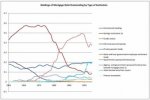The telling statistic is that Frank is the 17th House Democrat to announce he will not seek re-election, compared with six Republicans.But there may be another reason for Frank’s rather abrupt and unexpected departure. The Republicans have a better-than-even chance of capturing control of both Congress and the White House in 2012. At which point they might just be inclined to try to get to the root of what caused the 2007-2008 debacle that cripples our economy to this day.
And in so doing, they might just discover what has been painfully obvious for well over a decade: namely, that our financial savior, Barney Frank, along with his giveaway, vote-buying policies was actually one of the prime causes of the mortgage collapse and the ensuing Great Recession which, economic pronouncements to the contrary, remains with us still.
In a nutshell, the much-maligned Bush Administration recognized the Fannie-Freddie problem early on. Slowly, relentlessly, from the 1980s on, mostly Democrat-controlled Congresses pushed both quasi-governmental entities to prod banks into ever more liberal loan policies that would allow less and less qualified loan applicants to obtain mortgages and—often for the first time—purchase housing, regardless of whether they were financially able to carry their mortgages.
The problem became acute in the early 2000s as lower and lower down payments and “liar loans”—loans that required little if any substantiating documentation—became the norm. The Bush Administration—along with eventual GOP presidential candidate John McCain—tried to put an end to these practices, but to no avail. Frank, the Democrats, and a substantial number of incredibly stupid Republicans steadfastly opposed legislation geared toward heading off the already-gathering fiscal storm.
Barney Frank flees the scene of his fiscal crimes | Washington Times Communities





